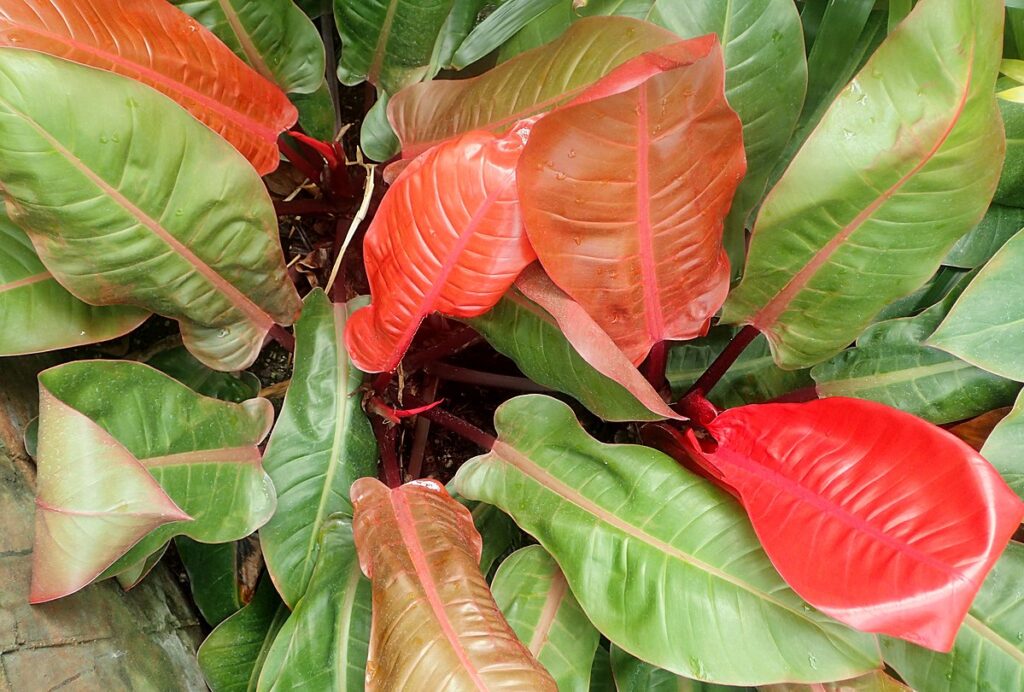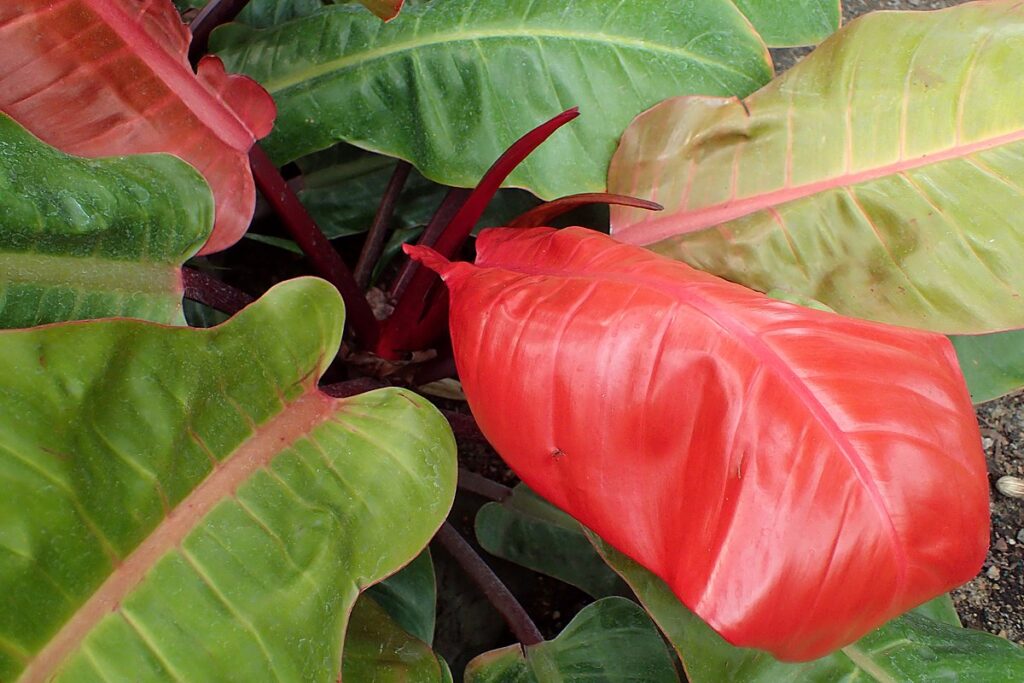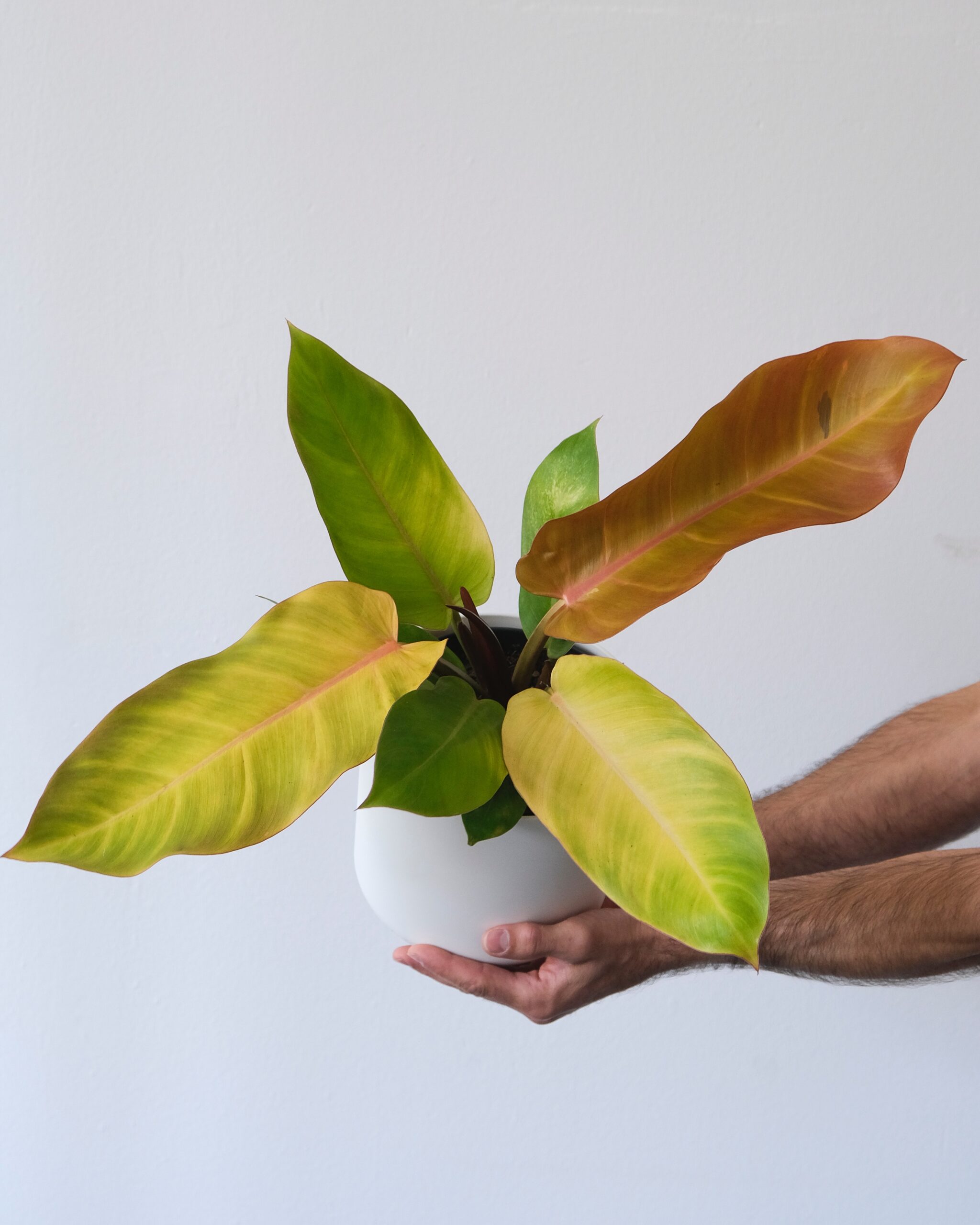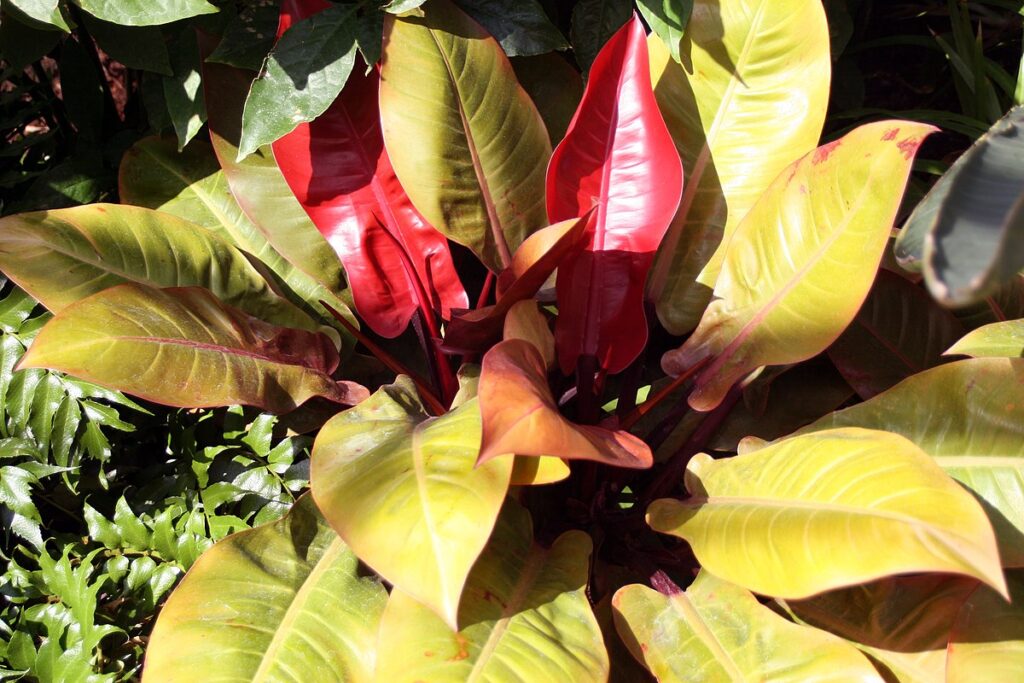The Philodendron “Prince of Orange” plant is a magnificent specimen of Philodendron beauty. It is a member of the vast Araceae family of tropical forest inhabitants. However, this particular exotic plant is a hybrid that is unique to an artificial environment.

Philodendron “Prince of Orange” cultivators agree that this species is certainly a show stopper. This plant’s leaves initially unfold with a rich orange-bronze tint before changing to salmon as time passes and eventually turning golden. A fully developed leaf eventually changes to a light green color that gradually darkens with age.
RELATED: 9 Stunning Rare Philodendrons; With Tips To Help Them Thrive
What a colorful riot of hues it is when all the colors are present on one plant!
The essential care requirement for “Prince of Orange” philodendrons is to recreate a tropical environment. “Prince of Orange” must have year-round access to warmth, wetness, bright light, and humidity in order to thrive. In addition, they need a soil that is loose, rich in organic matter, and well-draining. Room temperatures between 65 and 80 degrees Fahrenheit are ideal for them (18 and 27 degrees Celsius).
To know more about this magnificent plant’s care, continue reading below as we unravel the tips and tricks in growing Philodendron Prince of Orange in this article.
Profile – Philodendron Prince Of Orange
General Information – Philodendron Prince Of Orange
The Philodendron Prince of Orange, also known as Philodendron Tricolor and Orange Prince. Large, is a tropical plant that has distinctively colored leaves that change color over time, especially those in various hues of salmon.
On this plant, the heart of the new growth starts off bright yellow and gradually transitions to a more coppery shade before turning dark green.

As indoor plant, Philodendrons do well in any low-light environment and thrive in brilliant indirect light. In some locations, this Philodendron plant may be cultivated outside, making it more than just a houseplant. You should plant Philodendron Prince of Orange between U.S. Department of Agriculture plant hardiness zones 9 and 11 if you want it to thrive outside.
The Philodendron Tricolor belongs to the genus Philodendron and is a member of the Araceae family. It is a hybrid based on South American species.
This Philodendron hybrid, which is typically regarded as being relatively inexpensive to purchase, provides outstanding value and style for the home gardener. When cultivated inside, it hardly ever produces inconsequential, little white flowers in the spring.
Etymology – Philodendron Prince Of Orange
The Greek words “philo,” which mean “love” and “affection,” and “dendron,” which means tree, are the origin of the name “philodendron.” With these meanings, the Philodendron is informally translated as “tree huggers.” This is due to the fact that they are frequent tree climbers in the wild.
Flowering
Philodendron Prince of Orange can produce flowers under the correct conditions, though it is rather unusual for them to do so indoors. The likelihood is that it will display its blossoms in the wild, where they would naturally occur.
Not its flowers, the Philodendron is renowned for its foliage. But in the spring, you might notice little white blossoms. Prince of Orange is more frequently employed in outdoor landscaping, although it can also appear in indoor plants that receive a lot of indirect light.
Season Of Interest And Purchasing
A stunning and striking plant that will stand out in your collection of houseplants is the Prince of Orange Philodendron. The best time to enjoy this magnificent plant is in the summer or even in the early spring when it is actively growing because it grows swiftly.
Obtaining Philodendron Prince of Orange plants can be done in a variety of methods. This plant is probably available from a reputable nursery, but many online shops sell this beautiful plant.
Pricing ranges from $10 for cuttings to $50 for larger or more mature plants of the Philodendron Prince of Orange.
In particular, if you’re buying this plant during the colder months, you might want to think about asking for a warming pack with the purchase if you’re buying it online. This will lessen the plant’s exposure to serious stress while traveling.
Growth
The Philodendron Prince of Orange grows to a height of 24 to 36 inches when used as a houseplant. It looks fantastic in any low-light space away from the sun because of its height and bulk.
RELATED: Philodendron gigas: The Care, Propagation, and Watering Guide You Need
| Philodendron Prince of Orange Overview | |
| Scientific name | Philodendron erubescence ‘Prince Of Orange’ |
| Common name/s | Philodendron Prince of Orange, Philodendron Tricolor |
| Family | Araceae |
| Growth Habit | Herbaceous, Epiphytic Vine |
| Height and Spread | up to 3 feet in height, and three to six feet in spread |
| Classification based on life cycle | Perennial |
| Origin and Distribution | Native to South America |
| Climate Zone | Generally mild climate |
| USDA Plant Hardiness Zone | USDA Zone 9-11 |
| Color | Long, oval leaves that range in color hues from bright orange to green |
Care Tips – Philodendron Prince Of Orange
Light Requirement
The Prince of Orange Philodendron species, like many others, benefit from bright indirect sunlight. Because in this kind of light, their leaves take on a vibrant colors of green and orange and seem more luxuriant. However, too much direct sunlight could scorch the vegetation. So, additionally, they can tolerate a little less light than houseplants.

Your Philodendron might benefit from some assistance over the cold months. You can use grow lights, particularly if your plant is located in a dimly lit room at home or in a workplace where light is in short supply. Make sure your plant receives the proper quantity of strong indirect light; it will help it develop even better.
It is a sign that your Philodendron plant is not getting enough light if it begins to grow lanky, lengthy leaves and leaves with wide spaces between the internodes. So once more, prolonged exposure to direct sunlight is definitely not recommended if you don’t want crunchy leaves!
Temperature Requirement
Your gorgeous plant should be kept at a temperature of 65 to 80 degrees Fahrenheit. It can endure low temperatures as low as 54 degrees Fahrenheit (12 degrees C), but it will grow slowly and may wilt. In addition, if you keep your plant outside of this temperature range for an extended period of time, you should anticipate health problems or a seizure.
Keep plants away from exterior doors that open and close frequently to prevent temperature fluctuations. The plant will suffer if there are frequent temperature changes, and its leaves won’t be strong. Since misting aids in moisture retention and lowers temperature fluctuations, it might be a solution.
Water Requirement
The water needs of the Philodendron Prince of Orange are typically the same as those of other Philodendrons. But it prefers moist soil that is damp but not drenched. After sufficiently watering your plant, you will learn its preferences, which may take some adjusting and getting used to. However, it is crucial to avoid overwatering since it can result in root rotting, one of the main causes of Philodendron fatalities.
Check the soil before you water your plant. After that, insert your fingers into the topsoil; if they come out entirely dry, water the plant. Please take note of its leaves as well. Your plant is being overwatered or underwatered if its leaves begin to droop or turn yellow.
Depending on your interior air quality, climate, and moisture level, adjust your watering plan for your Prince of Orange to roughly twice a week in order to prevent this. For this plant, tap water is acceptable.
Humidity Requirement
Given that it is native to the South America, Philodendron Tricolor prefers warm, humid climates. When the humidity is 70% or more in their natural habitat, they can grow to extraordinary sizes.
It will continue to thrive when kept as a houseplant at a humidity range of 45–50%. A humidifier can increase the humidity or provide additional humidity, which can encourage your plant to produce larger, stronger leaves.
Soil Requirement
Philodendron Prince of Orange grows best in soil that is well-drained, aerated, and abundant in organic materials for the roots. This plant thrives in a rich, permeable potting soil with organic elements for essential nutrients.
Use 1 part potting soil mixed with 1 part each of orchid bark, perlite, and peat moss or coco coir to create the ideal potting mix for your Philodendron Prince of Orange. They have a high amount of organic elements and do well in quick-draining potting mixes.
Use this potting mixture to stop becoming muddy or flooded. This will allow extra moisture to drain in order to keep the pot from being saturated.
Fertilizer Requirement
Philodendron Prince of Orange will need fertilizer to provide it the nutrition it needs during the growing season.After receiving routine fertilization, it grows well and develops strong leaves.
During the growing season, fertilize it once a month using a well-balanced, water-soluble fertilizer like organic plant food. The ideal fertilizer to use is a balanced fertilizer like N-P-K, 10-10-10, or 20-20-20, applied at half the recommended strength.
Space Requirement
The Philodendron “Prince of Orange” can be grown in a pot for an extended period of time without having to worry about it attempting to climb. The flamboyant plant’s self-heading growth pattern keeps the stem extremely short and the leaves stacked tightly on top of one another.
The outcome is a stunning rosette structure that resembles a bouquet made of the multicolored foliage. However, the plant does occupy some side space. Therefore, be cautious to position it away from busy areas.
Philodendron “Prince of Orange” can be grown in a small pot on a tabletop when it is little, and as it grows, it can be moved to a position that is appropriate for its size.
Growing And Planting Tips – Philodendron Prince Of Orange
Propagation
Soil propagation and water propagation are your two alternatives for growing Philodendron Prince of Orange. However, Prince of Orange, like other Philodendron plants, reproduces swiftly in water.
RELATED: Philodendron Paraiso Verde: The Complete Care, Watering, and Propagation Guide

The precise steps to effectively propagate Philodendron Prince of Orange are listed below:
Water Propagation
Choose a stem in your mother plant that is healthy and has a node that is between one and three inches long. Just below the leaf’s node, make a cut. Put the stem cutting in a container of water. The plant nodes must be submerged, so check that. The stem cuttings should be placed in an area with abundant bright, filtered sunshine.
Change the water at least once every week to prevent the buildup of rotting microorganisms. Wait a few weeks for the root to grow and mature. You can then transfer the plant roots into a soil-filled pot once they are about an inch long.
Soil Propagation
Select a stem with one node and a single leaf in good health. Remove the node and 1 inch of the stem from the stem. The stem should then be planted in the soil to support growth, making sure the node is also present. Watch it carefully and wait till the cuttings have rooted. After that, you can transfer it to a pot, place it somewhere bright, and water it.
Pruning
Stem pruning can make the plant appear fuller. By pruning the plant to promote new growth, you can remove lanky vines and produce a bushier plant by using a pair of sterilized pruning shears. Philodendron Prince of Orange should be pruned in the spring and summer when it is actively growing.
Potting And Repotting
Since Philodendron “Prince of Orange” are naturally epiphytic plants, you can grow them in a root-bound arrangement.
Only when the roots completely fill the existing pot and the plant becomes top-heavy do you need to repot it. You’ll be able to tell by the plant’s exceedingly slow growth. Additionally, pick a sturdy pot that can sustain the plant’s weight. Planters made of terracotta with drainage holes are ideal for that use.
Repotting mature plants every two to three years may be necessary. Repotting should only be done in the spring and summer.
| Philodendron Prince of Orange Care | |
| Light | Bright indirect light |
| Temperature | Intermediate to warm, 65-80 degrees Fahrenheit |
| Water | Once a week, increased in summer, decreased in winter |
| Soil | Airy, well-draining soil; not too loose |
| Fertilization | Regular household fertilizer, once a month |
| Space | Plenty of space to spread |
| Propagation | Via water and soil propagation |
| Blooming | Rarely blooms, enough sunlight and maturity needed |
| Pruning | Regular pruning |
| Potting | Regular potting mix, use of horticultural charcoal, perlite and coco coir |
Problems And Troubleshooting – Philodendron Prince Of Orange
Overwatering
Philodendron Prince of Orange prefers not very wet soil. Overwatering is the most frequent reason for root rot in this plant. Yellowing leaves might also result from using too much water. Try changing your watering practices to be more in line with the recommendations for your plant if you are seeing this with your plant.
If you ever have overwatering, try these tips:
- First, reduce watering so that the soil can dry out.
- Make holes in the pot to let the excess water out.
- Put the plant in a well-lit area.
- Before repotting into a new container, a fungicide should be administered.
Underwatering
This is unusual with your Philodendron Prince of Orange, but you’ll typically see wrinkled leaves, dark margins, brown leaf tips, and fading foliage as a result of underwatering.
Simple solution: water your plants. Plants will remain content and healthy if their basic needs are met. Water your plants appropriately for the season and the surroundings.
Nutrient Deficiency
Nutrient deficiency is evident by stunted development, browned leaves, paler patterns, and other symptoms. Feed your plant to encourage root growth and stronger leaves to prevent this issue. However, if you have a premium organic potting mix, you won’t need to apply much fertilizer to this house plant.
Apply the proper, balanced fertilizer to correct this; calcium-rich fertilizer is what you want. However, it is important to check the fertilizers’ potency as well because too much of it could injure plants and cause your Philodendron Prince of Orange to grow slowly or stunted.
Drooping And Yellowing
Yellowing or other leaf discoloration indicates that your plant receives too much direct sunshine. As a result, you can decide to relocate it to a new spot where it won’t receive as much direct light or where sheer curtains will shadow it.
Drooping can be caused by too much or not enough water. Adjust your watering plan accordingly, and always examine your soil before watering your Prince of Orange to remedy this.
Flowering Problems
Most plant collectors are not so eager about this flower since its blossoms are less attractive than its lovely foliage. Additionally, Philodendrons rarely bloom indoors.
However, the Prince of Orange Philodendron can produce blooms when the right conditions are met if you want flowers. Keep the soil evenly moist and stop it from drying out completely. Ensure that the plant gets plenty of indirect, bright light.
Diseases
If a plant is not adequately cared for, it can get diseases. Notably Septoria Leaf Spot and Alternaria Leaf Spot, which cause fungus development, damage plants in this family. These are frequently brought on by overwatering the plants. Therefore, when you notice yellowing (Septoria) or brown spots, respond right away (Alternaria).
You can use a fungicide with a copper base to treat your plants, and for future prevention, pay close attention to how often you water them.
Pests
Unfortunately, Philodendron is not an exception to the rule regarding houseplants and pest issues.
In order to prevent additional infestation, it is best to remove the plant with the infestation and keep it away from the other plants in your collection. In addition, it is best to be proactive and isolate the affected plant because these pests enjoy moving from plant to plant.
Spraying neem oil on your plant is the next step, and it’s also the simplest and easiest. To prepare this spray:
- Combine two teaspoons of neem oil and one teaspoon of soap in a spray container.
- Fill the bottle with water, then shake it well.
- Spray the plant sparingly, making sure to get the undersides as well, and repeat the procedure every 5-7 days.
Natural pesticide neem oil makes it harder for these insects to breathe.
| Philodendron Prince of Orange Pests and Diseases | ||
| Common Pests/Diseases | Symptoms | Treatment and Prevention |
Common diseases include crown rot, stem rot, root rot, leaf spot, fungal diseases, and Xanthomonas infection | Yellowish rimming around black or dark brown spots on leaves | Avoid overwatering. Keep soil dry. Avoid too high humidity.Proper ventilation is needed around the plant. Remove infected parts of fungal infections to avoid spreading |
| Common pests include mealybugs, spider mites, aphids, and scales | Visible insects on the surface | Spray plant with warm, soapy water. If infestation is present, use insecticide or neem oil. Use diatomaceous earth. |
Problems With People And Animals – Philodendron Prince Of Orange
Toxicity
Sadly, all Philodendron species can be harmful. Since this plant contains calcium oxalate crystals that can be deadly if swallowed, it is bad for both people and animals. After consumption, it may result in mild poisoning symptoms, such as skin irritation and mouth, lip, and tongue burning. Keep kids and pets away from this plant.
Philodendron Plants Meaning And Symbolism – Philodendron Prince Of Orange
Philodendrons are considered to represent a love of nature, making them ideal for those who are passionate about plants and eco-friendly living. They also stand for personal development, so they are the perfect present for anyone going through a significant life change or trying to better themselves.
| Philodendron Prince of Orange Symbolism and Meaning | |
| General Meaning | love of nature, passion for eco-friendly living |
| Symbolism | Personal growth |
Landscaping and Gardening Ideas – Philodendron Prince of Orange
Companion Plants
Philodendrons pair well with other tropical plants, particularly Monsteras and other Aroids. Bird of paradise, areca palms, fire spike, heliconia, variegated arboricola, croton, chenille plant, and pentas are a few of the plants you might take into consideration.

Some of these plants will also have warm orange and red tints and extra colors, which will go beautifully with your plant.
Here are some excellent plants to grow with your Philodendron Prince of Orange:
Pothos
Both in terms of requirements and appearance, they are pretty comparable. Moreover, considering that pothos and philodendrons demand similar maintenance, they can be effectively cultivated together.
Schefflera
Schefflera can tolerate and even prefer average levels of light, humidity, and water. So it might complement your Philodendron Prince of Orange wonderfully. Schefflera has very decorative glossy, hand-shaped leaves. They also act as air fresheners, creating a straightforward and appealing mix.
Landscaping Ideas – Philodendron Prince Of Orange
Philodendrons look great as accent plants on a comfortable deck or patio, a damp interior, or both. A whole plant can also be positioned in a house corner or along the entranceway.
In addition, it can be used as a filler plant outside in a garden corner, between palm tree trunks, or below large trees. As long as it won’t be splashed at, it can even be placed close to swimming pools to provide even more tropical vibes.
| What to plant with | Other Aroids, Bird of Paradise, Areca Palms, Fire Spike, Heliconia, Variegated Arboricola, Croton, Chenille Plant, Pentas |
| What NOT to plant with | Basically nothing |
FAQS
Is Philodendron Prince Of Orange Toxic To Pets?
Pets should not be near this plant. Similar to other plants in the Araceae family, this plant has calcium oxalate crystals. These compounds are released when the plant is chewed, penetrating tissue and irritating the mouth and GI tract.
Any portion of the plant could cause symptoms in pets, including vomiting, appetite loss, and excessive drooling.
Is It Possible To Propagate Prince Of Orange Via Seeds?
Yes, technically. However, for this to happen, the plant must blossom, and plants grown in pots indoors rarely do so. Professional nursery growers use tissue culture as their propagating strategy.
How Can I Make My Prince Of Orange Look Bushier?
You can’t prune this particular variety of self-heading Philodendron. You can make it grow bushy by providing an excellent fertilizer that promotes leaves and enough bright light to support strong development.
Conclusion
With its enormous, changing-color leaves, the Philodendron Prince of Orange is the ideal choice for plant aficionados. The good news is that it simply needs indirect sunshine, average humidity, relatively moist soil, and comfortable temperatures to thrive.
If you want to know more about growing Philodendrons, then you can read our guide on propagating Philodendrons and top reasons why your Philodendron is changing colors.
Use these suggestions to start growing this Philodendron immediately if you’re seeking a new plant for your collection or are just getting started with indoor gardening!
We hope you learned something from this article, here are other articles that you can learn from:
Philodendron Pink Princess: The Perfect Care, Propagation, and Watering Guide
Philodendron Micans: The Complete, Care, Propagation Guide You Need
Philodendron gloriosum: The Fail-proof Care, Propagation, and Watering Guide You Need







